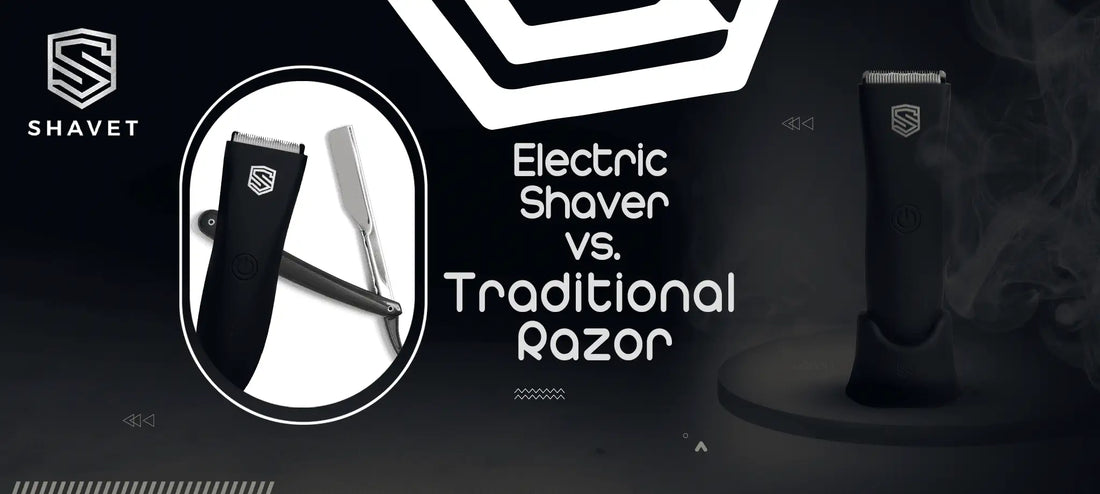Electric Shaver vs. Traditional Razor: Which One Offers a Better Shave?
Shaving is a crucial part of men’s grooming, but choosing the right tool can make all the difference. The debate between an electric shaver vs. traditional razor has been ongoing for years, with each offering unique benefits. While some men prefer the convenience of an electric shaver, others swear by the precision of a traditional razor. At SHAVET, we understand that the right shaving tool depends on your lifestyle, skin type, and personal preferences.
In this guide, we’ll break down the differences between an electric shaver vs. traditional razor, helping you make an informed decision about which one is best for your grooming routine.
The Advantages and Disadvantages of an Electric Shaver
An electric shaver is a modern grooming tool designed for convenience and efficiency. Whether you’re in a hurry or want to avoid nicks and cuts, an electric shaver offers a fast and effective shaving experience.
Advantages of an Electric Shaver:
- Speed & Convenience – One of the biggest advantages of an electric shaver is its ability to provide a quick shave. You can use it on dry skin, eliminating the need for shaving cream or water.
- Skin-Friendly – Electric shavers are designed to reduce irritation, making them ideal for men with sensitive skin. They glide smoothly over the skin without direct contact with sharp blades.
- Versatility – Many electric shavers come with adjustable settings for different beard lengths, making them a great choice for maintaining stubble or a full beard.
- Long-Term Cost Efficiency – While electric shavers may have a higher initial cost, they don’t require frequent blade replacements, making them a cost-effective option over time.
- Less Risk of Cuts & Razor Burns – Unlike traditional razors, electric shavers reduce the chances of nicks and cuts, making them a safer option for beginners.
Disadvantages of an Electric Shaver:
- Not as Close as a Shave – While electric shavers provide a smooth finish, they may not shave as closely as a traditional razor. Some men find they need to shave more frequently.
- Requires Charging or Batteries – Electric shavers need to be charged or powered by batteries, which can be inconvenient when traveling.
- Higher Initial Cost – A high-quality electric shaver costs more than a standard razor, but its durability and features make it a worthwhile investment.
Despite these drawbacks, electric shavers remain a popular choice for men who prioritize convenience, comfort, and efficiency.
The Benefits and Drawbacks of a Traditional Razor
A traditional razor has been the go-to grooming tool for centuries, offering a close, clean shave that’s hard to beat. Whether you use a cartridge razor, safety razor, or straight razor, traditional shaving remains a classic method for achieving a smooth finish.
Advantages of a Traditional Razor:
- Extremely Close Shave – Traditional razors provide the closest shave possible, cutting hair at the skin level for a smooth and polished look.
- Affordable & Accessible – Traditional razors are widely available and come at a lower price than electric shavers. Disposable razors and cartridge razors are budget-friendly options.
- Precision & Control – Traditional razors offer better control, making them perfect for detailed grooming, such as shaping beards and sideburns.
- No Need for Charging – Unlike electric shavers, traditional razors don’t rely on batteries or charging, making them a reliable choice anytime, anywhere.
Disadvantages of a Traditional Razor:
- Higher Risk of Cuts & Irritation – shaving machine price in saudi arabia with a traditional razor requires skill and care to avoid nicks, cuts, and razor burns, especially for men with sensitive skin.
- More Time-Consuming – Traditional shaving involves multiple steps, including applying shaving cream, lathering, and rinsing, making it less convenient for those with busy schedules.
- Frequent Blade Replacements – Razor blades dull over time and require frequent replacements, leading to higher long-term costs.
- Not Ideal for Traveling – Traditional shaving requires water, cream, and multiple accessories, making it less convenient for on-the-go grooming.
For men who prefer a classic, precise shave, a traditional razor remains a top choice. However, those looking for a faster, hassle-free experience may find an electric shaver more suitable.
Electric Shaver vs. Traditional Razor: Which One Should You Choose?
When deciding between an electric shaver vs. traditional razor, consider the following factors:
- Skin Sensitivity: If you have sensitive skin, an electric shaver may be the better choice as it minimizes irritation and reduces razor burn.
- Shaving Frequency: If you prefer shaving daily, an electric shaver offers a quicker and more comfortable experience. If you shave less often but want a smooth finish, a traditional razor might be best.
- Lifestyle & Convenience: If you travel frequently or need a fast grooming solution, an electric shaver is ideal. If you enjoy the ritual of shaving and have time to invest in it, a traditional razor is a great option.
- Budget Considerations: While traditional razors have a lower upfront cost, blade replacements add up over time. An electric shaver has a higher initial cost but can last for years with proper maintenance.
- If you value speed, convenience, and skin protection, go with an electric shaver.
- If you prefer a close shave, precision, and a traditional grooming experience, choose a traditional razor.
At SHAVET, we offer a premium selection of electric shavers and traditional razors, ensuring you find the perfect grooming tool for your needs. Whether you prioritize efficiency or precision, we have the right products to elevate your shaving routine.
Explore The SHAVET Trimmer today and enjoy the ultimate grooming experience, tailored just for you.

